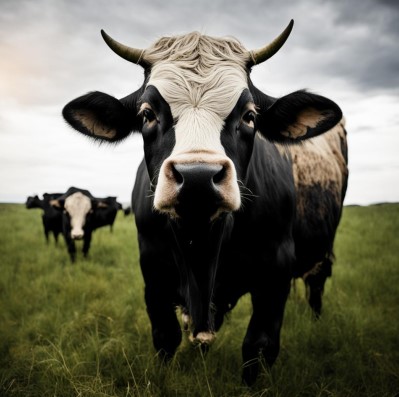- Antibiotics Tests in Milk
- Inhibitory detection test
- Laboratory equipment
- Centrifuges
- Indicator strips
- Autoclaves
- Scales
- Thermometers
- Packing
- PureTrust ATP monitoring
- ATP monitoring PIONEERPRODUKT CleanTrust
- MICROFAST® substrates
- Nutrient media
- Ice cream sticks
- Consumables
- Detergents and disinfectants
- Treatment agent
- Milk filters
- Wipes
- Gloves
- Sampling
Decline in pig numbers in Spain: causes and consequences

Reasons for the decline in the pig population in Spain
Spanish Royal Decree 159/2023 on animal protection: The Decree includes more stringent requirements for the conditions of keeping sows and pigs compared to European standards. The regulation, which aims to end the practice of pig tail docking, includes new requirements for the maximum density of animals on farms and new conditions regarding feeding, water, feed troughs, the environment and access to materials that allow animals to thrive more naturally on the farm.
Decline in pork exports to CHINA and other non-EU countries: Pork exports from Spain to China, the world's largest pork importer, fell in 2022 due to increased domestic production in China and lower demand for imported pork. Declining exports to China and other non- EU countries have had a significant impact on the Spanish pork market.
Outbreaks of porcine respiratory syndrome (PRRS): Several outbreaks of PRRS in Catalonia and Aragon in 2022 also contributed to the decline in pig production in Spain. PRRS is a highly contagious viral disease that can cause respiratory problems, loss of appetite and decreased productivity in pigs.
Consequences of a decrease in the number of pigs
Increase in pork prices: The decrease in pork production in Spain has led to an increase in pork prices. According to the sector, the main reason for this decline is more stringent requirements for pig housing, which leads to increased costs for producers.
Decline in pork exports: The decline in pig numbers has also led to a decline in pork exports from Spain. Spanish pork exports to China fell in 2022, and the decline in pork exports to China and other non-EU countries is expected to continue in 2023 and 2024 .
Increase in pork imports: Declining pork production in Spain has also led to an increase in pork imports into the country. In 2022, pork imports in Spain increased by 2% compared to 2021. The country's pork imports are expected to continue to rise in 2023 and 2024.
 PIONEER MEIZHENG BIO-TECH (5 in1) JC1165 / Rapid tests for the determination of the residual amount of halofuginone, flavomycin, novobiocin, flunixin, dexamethasone / prednisolone in milk, whey
PIONEER MEIZHENG BIO-TECH (5 in1) JC1165 / Rapid tests for the determination of the residual amount of halofuginone, flavomycin, novobiocin, flunixin, dexamethasone / prednisolone in milk, whey PIONEER MEIZHENG BIO-TECH (5 in1) JC0586 - Antibiotic tests 5 in 1 / Rapid tests for determining the residual amount of β-lactams, tetracyclines and cephalexin in milk, whey
PIONEER MEIZHENG BIO-TECH (5 in1) JC0586 - Antibiotic tests 5 in 1 / Rapid tests for determining the residual amount of β-lactams, tetracyclines and cephalexin in milk, whey PIONEER MEIZHENG BIO-TECH (5 in 1) JC0726 / Rapid tests for determining the residual amount of Bacitracin, ansamycins, clindamycin, spiramycin, florfenicol in milk, whey
PIONEER MEIZHENG BIO-TECH (5 in 1) JC0726 / Rapid tests for determining the residual amount of Bacitracin, ansamycins, clindamycin, spiramycin, florfenicol in milk, whey TEST KIT for determination of inhibitory agents PIONEERPRODUKT® DASH-TEST, WC0040
TEST KIT for determination of inhibitory agents PIONEERPRODUKT® DASH-TEST, WC0040 ANTIBIOTICS / ELISA TESTS
ANTIBIOTICS / ELISA TESTS Rapid tests for determining the residual amount of chloramphenicol in meat
Rapid tests for determining the residual amount of chloramphenicol in meat- PIONEER MEIZHENG BIO-TECH (5 in1) JC0871/ Rapid tests for the determination of the residual amount of β-lactams, tetracyclines, chloramphenicol, streptomycins, ceftiofur in milk, whey.
- Express tests for determining the residual amount of β-lactams, tetracyclines, chloramphenicol, streptomycins in milk, whey
- Express tests for determining the residual amount of β-lactams and tetracyclines in milk, whey
- Express-tests PIONER 5 in1 for the determination of thiamphenicol, meloxicam, colistine, trimethoprim, sulfonamides
 Nova Safety milk centrifuge (Germany)
Nova Safety milk centrifuge (Germany) HI 98509 Checktemp 1 Portable Electronic Thermometer with Remote Sensor
HI 98509 Checktemp 1 Portable Electronic Thermometer with Remote Sensor Heating plate Tagler PN-4030SK
Heating plate Tagler PN-4030SK RT5 Multi-Magnetic Stirrer with Heating, IKA
RT5 Multi-Magnetic Stirrer with Heating, IKA Automated measuring complex "Laktan 1-4M" isp. 700
Automated measuring complex "Laktan 1-4M" isp. 700 Milk quality analyzer "Laktan 1-4M" isp. Mini
Milk quality analyzer "Laktan 1-4M" isp. Mini- Overhead stirrer WB2000-M
- AE aquadistillers (Livam, Russia)
- LAC S Series Vertical Laboratory Autoclaves (South Korea)
- Smooth micrometers MK
- Laboratory thermostat-reducer "LTR-24"
- Drying oven Chizhovoy CHS-200 (Tagler, Russia)
- MKV milk gauge
- BA-CL- X.X ST TR titration table
- Milk quality analyzer "Laktan 1-4M" 500 isp. MINI
 Plastic packaging for cakes and pastries
Plastic packaging for cakes and pastries Salad dressings
Salad dressings Laminating paper KH PACK®
Laminating paper KH PACK® Cover
Cover Cartons for milk and dairy products
Cartons for milk and dairy products Laminating paper KH PACK®
Laminating paper KH PACK®- KH PACK® tartlet paper
- Backed Foil
- The paper packing fastened anticorrosive UNIK 14-70 THAT 5453-003-05773103-2005
- Grease and barrier paper KH PACK®
- Korreks for confectionery
- KH PACK® bag making paper
- Siliconized paper for hygiene products
- Ice cream chopsticks
- Parchment
 Ice cream sticks (with logo)
Ice cream sticks (with logo) Auxiliaries for sugar products
Auxiliaries for sugar products Ice cream sticks Standard 93
Ice cream sticks Standard 93 Ice cream sticks Standard 114
Ice cream sticks Standard 114 Ice cream sticks (round)
Ice cream sticks (round) Wafer cup and cone
Wafer cup and cone- J-Bottom technology
- Ice cream sticks Magnum (curly)
- Petri dish 90 mm
- GableTop aseptic packaging
- Pepsin whey pork
- General purpose environment of SPC "Biocompass-S" (Uglich)
 Drencher for feeding calves with a rigid probe
Drencher for feeding calves with a rigid probe Foam cup for udder treatment
Foam cup for udder treatment Hoof bath
Hoof bath Fall with a loop for cattle
Fall with a loop for cattle Non-returnable cup for udder treatment
Non-returnable cup for udder treatment Spatula for mastitis test (Shalm's test)
Spatula for mastitis test (Shalm's test)- Self-adhesive hoof bandage
- Sticky fly trap, 25cm*10m
- Forged pitchforks
- Pump for artificial ventilation of the lungs
- Anti-catfish milking rings
- Antibryk
- Apron and armlets
- Rubber rings for castration
- Mug for milking the first streams of milk, lengthwise
 Substrate for determining the number of staphylococci (Catalog number LR1005) MicroFast® Staphyloccocus aureus Count Plate
Substrate for determining the number of staphylococci (Catalog number LR1005) MicroFast® Staphyloccocus aureus Count Plate Yeast & Mold Count Plate (cat. no. LR1003) MicroFast® Yeast & Mold Count Plate
Yeast & Mold Count Plate (cat. no. LR1003) MicroFast® Yeast & Mold Count Plate MicroFast® Staphyloccocus aureus Confirmation Plate Staph.aureus Confirmation Plate (cat. no. LR1005Q)
MicroFast® Staphyloccocus aureus Confirmation Plate Staph.aureus Confirmation Plate (cat. no. LR1005Q) MicroFast® Environmental Listeria Count Plate
MicroFast® Environmental Listeria Count Plate Substrate for accelerated determination of QMAFAnM, (catalog number LR1321)
Substrate for accelerated determination of QMAFAnM, (catalog number LR1321) MicroFast® Bacillus cereus Count Plate (catalog number LR1010)
MicroFast® Bacillus cereus Count Plate (catalog number LR1010)- MicroFast® Salmonella Count Plate (SAL), for the determination of Salmonella in food and environmental samples (Catalog #LR1006)
- MicroFast® Coliform & E.coli Count Plate
- MicroFast® Lactic Acid Bacteria Count Plate (Part Number LR1312)
- MicroFast® Microbiological Substrates
- Coliform Count Plate (catalog number LR1002) MicroFast® Coliform Count Plate
- Substrate for determining QMAFAnM (catalog number LR1001)
- MicroFast® Enterobacteriaceae Count Plate (cat. no. LR1011)
 Калининградская область заинтересована в обмене опытом с Беларусью в мелиорации и закупке техники01.10.2025
Калининградская область заинтересована в обмене опытом с Беларусью в мелиорации и закупке техники01.10.2025 Belarusian exports of dry milk products to Myanmar quadrupled in the first half of the year. 01.10.2025
Belarusian exports of dry milk products to Myanmar quadrupled in the first half of the year. 01.10.2025 В ОАО "Агро-Колядичи" умеют получать завидные урожаи30.09.2025
В ОАО "Агро-Колядичи" умеют получать завидные урожаи30.09.2025- "Россь" не рассчитывает на авось30.09.2025
- Куда инвестирует бизнес? Узнали, какой город в Беларуси выбрал для вложений производитель протеиновых батончиков30.09.2025
- БУТБ обеспечит платформу для взаимодействия белорусского и индонезийского бизнеса28.09.2025
- В ОАО "Святая Воля" в Ивацевичском районе за полгода выручка на каждого работника составила Br98 тыс.27.09.2025
- Газ на пятилетку, вторая АЭС, защита общего рынка и Украина. Подробности переговоров Лукашенко и Путина27.09.2025
- Record-breaking animals are being raised at the Ross breeding farm in the Volkovysk district.26.09.2025
- Шашлычок, мясные шарики, гуляш, борщ. Посмотрели, чем кормят детей в школе и сколько это стоит26.09.2025
- At OJSC "Svyataya Volya" in the Ivatsevichi district, revenue per employee over the past six months amounted to Br98 thousand.26.09.2025
- OAO Ostromechevo invested over $18 million in livestock development.26.09.2025
- Farmers at Rogoznyansky JSC in Zhabinka District increased their grain yields by more than a third.25.09.2025
- В ОАО "Агро-Колядичи" самой урожайной культурой оказался ячмень25.09.2025
- Алтайский край заинтересован в развитии биржевой торговли с Беларусью25.09.2025
- Белорусские сахарные заводы начали экспортировать свекловичный жом в ОАЭ через биржу24.09.2025
 Суд подтвердил правомерность действий Россельхознадзора по отношению к мясоперерабатывающему предприятию из Архангельской области01.10.2025
Суд подтвердил правомерность действий Россельхознадзора по отношению к мясоперерабатывающему предприятию из Архангельской области01.10.2025 В Приморье владельцу коз вынесено предупреждение за игнорирование ветеринарных мероприятий01.10.2025
В Приморье владельцу коз вынесено предупреждение за игнорирование ветеринарных мероприятий01.10.2025 Мировой рынок органических и натуральных продуктов вырастет до $84 млрд к 2033 году01.10.2025
Мировой рынок органических и натуральных продуктов вырастет до $84 млрд к 2033 году01.10.2025- В Иркутской области Россельхознадзор провёл анализ более 140 проб пищевой продукции01.10.2025
- Тенденции и вызовы в агропромышленном комплексе России обсуждали на выставке «Агропродмаш-2025»01.10.2025
- Россельхознадзор открывает новые рынки для агропромышленной продукции01.10.2025
- Делегация Татарстана успешно посетила выставку CIFA в Китае01.10.2025
- Советы по борьбе с опасными заболеваниями животных: страны СНГ предпринимают совместные меры01.10.2025
- Проблемы "Токаревской птицефабрики": Новый иск на 64,8 млн рублей01.10.2025
- США могут стать вторым по величине рынком сбыта парагвайской говядины01.10.2025
- Ожидается рост производства свинины на Филиппинах01.10.2025
- Торговля агропродовольственными товарами ЕС остаётся стабильной, несмотря на рост цен01.10.2025
- Белгородская область провела всероссийскую конференцию по биобезопасности в АПК30.09.2025
- Рост производства мяса и молока в Ивановской области: инвестпроекты подстегивают отрасль30.09.2025
- Ямал демонстрирует умеренную инфляцию на фоне снижения цен на овощи и яйца30.09.2025
- Калининградские инспекторы предотвратили ввоз крупной партии птицеводческой продукции из Китая30.09.2025
 10 reasons to take a deposit04.05.2025
10 reasons to take a deposit04.05.2025 Губернатор назвал меры по борьбе с топливным кризисом в Хабаровском крае02.10.2025
Губернатор назвал меры по борьбе с топливным кризисом в Хабаровском крае02.10.2025 Bloomberg узнал о плане G7 значительно ужесточить санкции против России02.10.2025
Bloomberg узнал о плане G7 значительно ужесточить санкции против России02.10.2025- G7 заявила о проработке использования всей суммы российских активов02.10.2025
- Фон дер Ляйен заявила о смене подхода к санкциям против России02.10.2025
- США раскрыли долю поставляемого из России топлива для ядерных реакторов01.10.2025
- Евросоюз частично восстановит санкции против Ирана30.09.2025
- Yle узнал, что ЕС не планирует вносить российский никель в список санкций28.09.2025
- Иран сообщил о предложенной Штатами отсрочке санкций в обмен на уран28.09.2025
- Кремль отреагировал на планы ЕК изменить механизм продления санкций27.09.2025
- МИД ввел санкции против Британии и назвал ее меры «тришкиным кафтаном»27.09.2025
- Politico has learned that the European Commission has proposed changing the sanctions extension mechanism.26.09.2025
- В Венгрии подсчитали убытки из-за отказа от российского газа26.09.2025
- The FT reported on the German cellist's "too bold" ties to Russia.26.09.2025
- Bloomberg назвал условие Индии для отказа от российской нефти26.09.2025
- EUObserver узнал о нежелании ЕС закрываться от российских туристов25.09.2025
 В Британии предупредили о риске для миллионов из-за супербактерий06.01.2025
В Британии предупредили о риске для миллионов из-за супербактерий06.01.2025 Moscow court sides with Indian company in dispute with Health Ministry26.11.2024
Moscow court sides with Indian company in dispute with Health Ministry26.11.2024 Scientists estimate increase in mortality due to drug-resistant bacteria29.10.2024
Scientists estimate increase in mortality due to drug-resistant bacteria29.10.2024- Antibiotics for livestock and pesticides found in poisoned family's home29.10.2024
- Izvestia reported on the shortage of widely used antibiotics in Russia29.10.2024
- The Ministry of Health called data on the shortage of antibiotics unreliable29.10.2024
- Scientists warn of threat of return to pre-penicillin times29.10.2024
- The Ministry of Health explained how attitudes towards antibiotics changed during the pandemic07.05.2024
- WHO explains the risks of taking antibiotics "just in case"06.05.2024
- Doctors warn of bad practices after government decision on antibiotics25.04.2024
- The Ministry of Health removed antibiotics and hormones from the standard treatment of ARVI25.04.2024
- Antibiotics in oil: myth or reality?06.03.2024
- Antibiotics in sour cream: myth or reality?05.03.2024
- Antibiotics in goat milk: effects, problems and control measures16.02.2024
- The Japanese will stop producing the popular antibiotic vilprafen in Russia23.12.2023
- Antibiotics in Milk21.12.2023
 Antibiotics in pollock25.02.2024
Antibiotics in pollock25.02.2024 Antibiotics in herring: myth or reality?12.02.2024
Antibiotics in herring: myth or reality?12.02.2024 Antibiotics in perch10.02.2024
Antibiotics in perch10.02.2024- Antibiotics in sprat: facts and myths10.02.2024
- Antibiotics in tuna: an important health and environmental issue09.02.2024
- Antibiotics in meat30.01.2024
- Antibiotics in chebureks: myth or reality?29.01.2024
- Antibiotics in cutlets: problem or myth?18.01.2024
- Antibiotics in Chicken: Where Are the Highest Concentrations?17.01.2024
- Antibiotics in carp17.01.2024
- Where Are More Antibiotics in Chicken: Reality and Cautions16.01.2024
- Antibiotics in Salmon: Safety and Product Quality16.01.2024
- Antibiotics in Turkey15.01.2024
- Antibiotics in Sal: Reality and Safety Issues15.01.2024
- Antibiotics in Fried Dumplings: Facts, Risks and How to Stay Safe15.01.2024
- Antibiotics in sausages14.01.2024
 Antibiotics in Coffee: Myths and Reality03.05.2025
Antibiotics in Coffee: Myths and Reality03.05.2025 Forged forks: 10 interesting facts16.05.2024
Forged forks: 10 interesting facts16.05.2024 Swimming pool and weight loss: 10 interesting facts10.03.2024
Swimming pool and weight loss: 10 interesting facts10.03.2024- Tests for antibiotics in milk - 10 interesting facts07.03.2024
- Cleaning the kettle from scale, 10 interesting facts...06.03.2024
- Antibiotics in beer: 10 interesting facts04.03.2024
- Wild boar, how to survive...01.03.2024
- Purulent mastitis, 10 interesting facts27.02.2024
- Lemon and alcohol: 10 interesting facts25.02.2024
- Mint - 10 interesting facts25.02.2024
- Wild boar, 10 interesting facts20.02.2024
- Wild boar and domestic pig: comparison and advantages20.02.2024
- Cottage cheese, 10 interesting facts20.02.2024
- 10 Interesting Facts About Milk19.02.2024
- How to Clean a Toilet - 10 Interesting Facts (Acid vs Alkaline)18.02.2024
- Goat's milk: 10 interesting facts16.02.2024
 Dicroceliosis in cattle09.03.2024
Dicroceliosis in cattle09.03.2024 Demodicosis in cattle01.03.2024
Demodicosis in cattle01.03.2024 Purulent mastitis of cattle27.02.2024
Purulent mastitis of cattle27.02.2024- Hypodermatosis in cattle20.02.2024
- Hemonchoz in cattle11.02.2024
- Bursitis in cattle30.01.2024
- Brucellosis in cattle29.01.2024
- Bronchopneumonia in calves27.01.2024
- Bronchitis in cattle26.01.2024
- Mortellaro disease in cattle24.01.2024
- White muscle disease in cattle23.01.2024
- Babesiosis in cattle22.01.2024
- Cattle acidosis20.01.2024
- Arthritis in cattle20.01.2024
- Anaplasmosis in cattle18.01.2024
 Antibiotics for coughs: when they are needed and when they are not11.02.2024
Antibiotics for coughs: when they are needed and when they are not11.02.2024 Из-за пьяного бесправника погибли два человека. Следователи раскрыли подробности ДТП в Браславском районе02.10.2025
Из-за пьяного бесправника погибли два человека. Следователи раскрыли подробности ДТП в Браславском районе02.10.2025 В Бресте нетрезвая женщина попала под машину02.10.2025
В Бресте нетрезвая женщина попала под машину02.10.2025- "Картонная сверхдержава". С чем Польша готова шагнуть в 2026-й?02.10.2025
- A drunk mechanic hit a Gomel resident with his own car. The Investigative Committee has revealed details of the case.01.10.2025
- Хулиганство в интернете и реальной жизни. Верховный Суд обновил разъяснения для правоприменителей30.09.2025
- Compensation for moral damages, 4 years in prison. The perpetrator of a fatal accident near Gomel has been sentenced.30.09.2025
- She stabbed her partner in the back. The Investigative Committee has revealed details of the criminal case in Novopolotsk.27.09.2025
- За смену - десятки вызовов. Сотрудники ППС о спецзаданиях и необычных случаях 27.09.2025
- Как победить "осенний синдром"? Очень простые советы для хорошего самочувствия27.09.2025
- В Беларуси перенесены сроки введения прослеживаемости и маркировки товаров 26.09.2025
- Что является одной из основных причин травмирования на производстве, рассказали в ФПБ25.09.2025
- Минчанин лишился крупной суммы и золотого слитка после неудачного свидания 24.09.2025
- В центре внимания пешеходы и велосипедисты. ГАИ усилила контроль за соблюдением ПДД в Минском районе 24.09.2025
- Навигационные пломбы для отслеживания перевозок начнут применять на всей территории ЕАЭС24.09.2025
- В Минске пьяный водитель повредил девять припаркованных автомобилей24.09.2025
Persons
Our Partners
Top 10
Our Test - Pioneer Tests
- Express tests for determining the residual amount of β-lactams, tetracyclines, chloramphenicol, streptomycins in milk, whey
- TEST KIT for determination of inhibitory agents PIONEERPRODUKT® DASH-TEST, WC0040
- PIONEER MEIZHENG BIO-TECH (5 in1) JC0586 - Antibiotic tests 5 in 1 / Rapid tests for determining the residual amount of β-lactams, tetracyclines and cephalexin in milk, whey
- PIONEER MEIZHENG BIO-TECH (5 in1) JC0871/ Rapid tests for the determination of the residual amount of β-lactams, tetracyclines, chloramphenicol, streptomycins, ceftiofur in milk, whey.
- PIONEER MEIZHENG BIO-TECH (5 in1) JC1165 / Rapid tests for the determination of the residual amount of halofuginone, flavomycin, novobiocin, flunixin, dexamethasone / prednisolone in milk, whey


